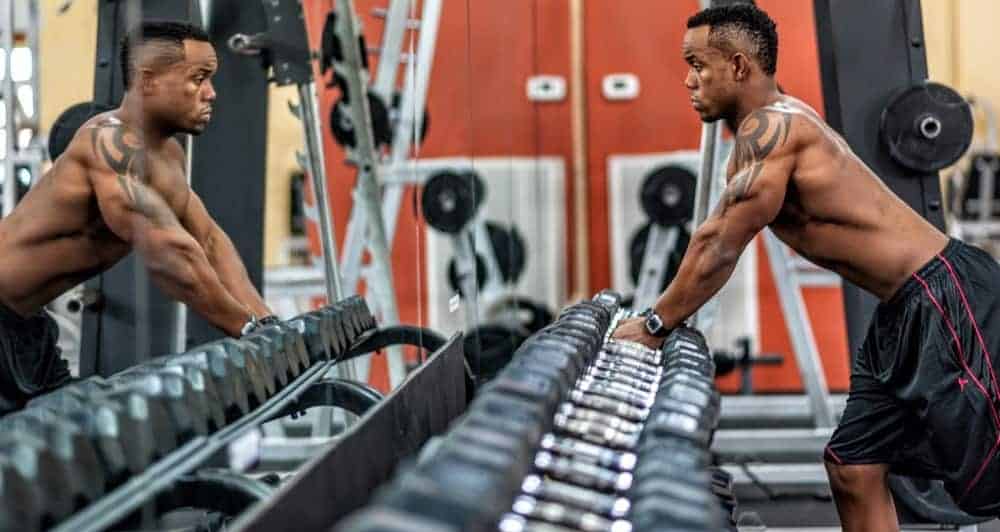There are hundreds if not thousands of different training techniques out there. A lot of professional athletes and bodybuilders evolved their own technique throughout their career.
For instance, the PIT Force system by Carsten Pfützenreuter, which I addressed in one of our latest articles.
Why do so many different techniques even exist?
Well, that cannot easily be answered flat rate, but there are obvious reasons behind it.
First of all, exercising should be fun, thrilling and challenging. Don’t get me wrong, I am not saying training should be easy, light or sloppy.
Certainly not.
There is no way around consistent, hard and dedicated work on the journey towards your athletic goals.
However, training neither has to be monotone nor boring. If that is the case for you, then, unfortunately, it doesn’t seem likely that you maintain the routine in the long-run.
That’s where training techniques come into play. In the course of time, your normal workout routine may lose its incentive, becoming tedious or tenacious.
Whenever you feel losing track, being in such a state, it’s time to try something new.
Whether supersets, giant sets or drop sets. There are many options to choose from.
Today’s article will address the latter.
What are drop sets? How do they work?
First and foremost, drop sets are a training method that is widely used in bodybuilding and strength training. The corresponding reasons are not surprising.
On the one hand, you can use drop sets to bring your muscles to failure several times over a short period of time. For one thing does this not only give you a huge pump but by the same token sore muscles, that you haven’t had for ages.
Drop sets are mainly used on account of its amazing impact on the muscle-mind connection and high workout intensity.
In addition, drop sets provide a great way to round off your heavy sets with lightweights, which helps to forestall injuries.

What are drop sets?
Essentially, drop sets depict a system where you perform one set of a particular exercise, then reduce the weight (by 20–30% as a rule of thumb) and continue with less weight.
No breaks in between.
After you repeat this procedure 1-3 times, the set is terminated.
Basically, in comparison to normal sets which you would terminate as you reached muscle failure or the fixed rep number, drop sets push further towards your limits.
A drop set will not be terminated when you reach muscle failure. Continue with lighter weight instead and until your muscles fail again.
In fact, a drop set is a number of consecutive sets of the same exercise with increasing intensity.
As mentioned earlier, you reduce your weight and do more repetitions where you would normally finish the set and start to rest.
That is very similar to pyramid training, just without taking breaks in between. Look for weights that you’re able to handle for 10-12 clean reps for the start and execute the set as normal.
Now here comes the difference into play.
After you’ve done 12 reps, don’t stop. Reduce weight. Now you should be able to follow up with another 8 reps.
Once more, without a break in between.
Follow the same procedure over and over again. In the next set, it’s probably not going to be more than 6 clean reps.
Depending on your energy level and condition, you could do the same thing for a third time.
The number of reps is changeable. There is no such thing as rigid given values.
12,10, 8, 6, 3,4 simply serves as an illustration, to make it more clear. Test how it feels for you and adjust the number of repetition to your preferences.
With this system, you will work intensively and purposefully towards muscle failure.
Honestly, muscle failure will be severe. You won’t even be able to do a single rep just with the bare bar afterwards.
Therefore, you should either save this technique for the end of the entire session or at least as the last exercise for one particular muscle group.
For example, if you train push (chest, shoulder, and triceps) on that day, keep the drop sets for the very last chest/shoulder/triceps exercise.
Overall, drop sets are excellent as an intensity technique to excite new stimuli that force your muscles to grow.
Despite all these benefits, beginners should treat it with caution!
Just as with supersets, techniques like these should rather become tools that you unpack once you’ve reached a training level or plateau.
Nonetheless, give it a shot if you want to, but make sure to start off easily and don’t overestimate yourself.
However, most importantly to mention, it does not make sense to use drop sets throughout a whole workout.
That does result in anything but does not lead you closer towards your goals.
In any case, drop sets are a lot of fun, induce sore muscles and provide a great mind-muscle connection followed by a huge pump.
Benefits of drop sets
Compared to traditional sets, drop sets have several advantages.

Metabolic stress
Metabolic stress is one of the three primary mechanisms that contribute to muscle growth.
This mechanism is characterized by high muscle tissue activation, the ticker and acute hormonal elevations.
However, how big these effects are, particularly with regard to other mechanisms, is still not clear yet.
Metabolic stress occurs especially at higher rep ranges, for which drop sets are excellent. By dropping the weight (repeatedly), one set can be continued much longer than normal.
Time under tension
Although with less certainty than metabolic stress, Time Under Tension (TUT) also appears to have an impact on muscle growth.
As the name implies, TUT illustrates the time a muscle is under tension during a set.
This can either be influenced by the speed of execution or the repetition number, with the last being achieved by drop sets.
Efficiency
With a drop set, you can execute several sets in quick succession, even if you usually count this as one set.
However, that probably means that you carry more weight over a shorter period of time. This makes drop sets an effective tool to use when you’re short on time, but still, want to get the most out of your workout.
Training volume
Volume often expressed in sets per muscle group, is the most important variable in muscle growth.
You’re not familiar with the basics of volume yet? Check out our free guide about the optimal volume for hypertrophy.
Drop sets automatically increase the volume because multiple sets are bundled into one “bigger” set. This means an increase in the total training volume, which in itself can have a positive effect on muscle growth.
Injury sensitivity
This is debatable, but drop sets can be effective if you are relatively sensitive to injuries. By reducing the weights, you train a greater part with lighter weights, which can reduce the stress on joints and tendons.
On the other hand, as presumably every set is going to lead to muscle failure, that in itself is a heavy burden and often makes it difficult to maintain proper technique for the very last repetitions.
Drop sets are often implemented as part of the workout to supplement the core foundation of your training program.
Just as supersets, you can implement them into your training every now and then but tools like these certainly don’t lay the foundation of your training.
As the weight must be lowered quickly after muscle failure, this technique works very well with isolation exercises on machines or with cables where you just have to replug the weight.
Drop set techniques and variations
Above all, just as the workout itself should be fun, drop sets should be so, too.
In order to make drop sets even more exciting and creative, I’ll give you an impulse with 10 different drop set methods and techniques that you can choose from.
Whenever you feel the urge to expend your last energy, get a better pump or just some have fun in the gym, remember this article and select one of the following methods.

1. Drop sets with the barbell
It’s the most classic. Drop sets with barbells.
Just as Arnold Schwarzenegger loved biceps barbell curls, I do so too. You will not only get a crazy pump in your biceps but also enable carrying relatively heavy weights.
2. Power drop sets
First, do 6 reps with a certain weight, then reduce it by 10-20% and execute another 6 reps. Afterwards, reduce the weight again by 10-20% and do 6 more reps.
Continue this method for as long as you can manage to get 6 reps done with clean (!) execution.
3. Drop sets with machines
Reducing the weight of plates with barbells can be quite time-consuming. To make things even worse, sometimes there are not even enough plates around.
Particularly those folks among you who train in discount gyms like McFit, Anytime Fitness or 24 Hour Fitness and experienced the peak times, you know what I am talking about!
Drop sets work incredibly well with machines. It avoids putting weight plates on and off all time and makes it overall a lot easier.
All you have to do is pull the pin out of the weight block and put it in a lower stack.
For example, on a biceps curl machine, you would not even have to leave your seat to replug the weight. This allows a quicker transition in between the sets which intensifies the whole thing even more.
4. Drop sets with dumbbells
Drop sets can be done wonderfully with dumbbells.
For example, biceps curls, butterfly, lunges or lateral side raises. There are multiple options to choose from.
Just take all the different dumbbells that you need and place them at hand so that you can grab the next pair of dumbbells once you’ve finished with the first pair.
5. Drop sets with halving the weight
This is a technique for the monster pump. Take a weight that you’re able to move for a maximum of 6 reps. After that halve the weight and perform a total of 20 reps.
Continue until muscle failure.
6. Rising drop sets
Actually pretty self-explanatory. Start with heavy weights as with the descending drop sets, but with fewer reps. Then reduce the weight and increase reps.
There is no right or wrong here, just try out different rep ranges (between 6-12 preferably) and see what suits you the best.
7. Drop sets with high weight loss
Here you take down 30% of the working weight after the first round of reps. Repeat that 3 times.
In the end, you’re practically standing there with the empty bar, but believe me, an empty bar has never felt this heavy 😉
8. Drop sets with low weight loss
For low weight drop sets, you will do your reps at a weight reduction by 20% each round. That can be a real challenge!
9. Drop sets with a minimal break
Actually, against the principle of drop sets, this method includes taking breaks in between. You deliberately rest for 5-15 seconds, so you can at least recharge your batteries for the next round of reps.
10. Zero break drop set
A drop set completed without break is almost impossible. I know according to the rule there are no scheduled breaks, but trust me, your muscle will be crazy pumped. It feels like you cannot move them anymore.
That’s what this method is about. Try to change weights as fast as possible to get as close to 0 rest as possible.
For example, you could do a drop set exercise on a machine, along with a training partner. All you need to do is execute the reps while he is replugging the weight after each round.
Practical tips for doing drop sets
Now, after we covered what drop sets are, how they benefit us and what different types and methods exist, I want to you give some practical tips when doing drop sets.
Here are some tips to optimize your drop set training.
1. Reduce the time of replugging weights to a minimum
As just mentioned, try to keep the transition as smooth as possible and avoid superfluous rest.
In general, the shorter the transition time, the more intense and effective your drop set will be. Do not dawdle around for long, and if possible train with a partner, that will help you to speed things up.
2. Go to the limit at the first reps
Whether you have set a goal of 6 or 12 reps for the first round. You should already be at the limit when doing the last rep.
3. Reduce the weight only 2-3 times
Basically, you can reduce the weight as many times as you want.
However, there seems to be a point where you just get too weak and nothing works anymore. This point is likely to be reached after 2-3 weight reductions.
4. Proper preparation
Of course, to reduce the transition time, it makes sense to arrange everything in advance. It not only makes sense, it is also necessary.
Place the weight plates, dumbbells or whatever you need at hand.
Even better, place them in the right order as you need them. Furthermore, rather take small weight plates (1.25, 2.5 and 5kg) instead of heavier (15 or 20kg). This makes everything easier and more adjustable.
5. Stay within 6-12 reps
Of course, you could go as low as one rep but drop sets are not meant to improve strength. It makes more sense to stay within hypertrophy rep ranges around 6-12 or even higher.
6. Use an empty gym for drop sets
Normally, it shouldn’t be done at all, reserving several dumbbells or weight plates, or occupying the entire squat rack for biceps curls.
Therefore, make sure you don’t restrict too many other athletes and save your drop sets for occasions when the gym is getting less crowded.
7. Don’t overuse drop sets
Use drop sets occasionally, but don’t make them part of your workout routine.
Drop sets are intense and require caution and common sense. If you would be doing this all the time, your strength would only increase very slowly if not even decrease.
The same applies to muscle growth.
I recommend not using drop sets more than once a week for the big muscles (legs, back, and chest) and every two weeks for the smaller muscles (shoulder, arms)
The bottom line
Finally, to close up this article, let’s round off with some personal advice.
As with any other intensity training technique: do not overdo their usage.
In the long run, it hurts more than it benefits you now. Don’t exaggerate and implement drop sets into every single exercise.
Drop sets are quite demanding for your nervous system and require a longer recovery time than conventional sets.
At this point, it has to be emphasized that, especially for natural athletes, the frequency is extremely important. You don’t want an unnecessarily long regeneration period.
Anyhow, don’t hesitate to give it a shot.
Drop sets are fun.
There is hardly a better way to get such a crazy pump by literally shocking your muscles.
Try out the different methods from above and chose your favourite!
What is your favourite drop set variation? Do you regularly implement drop sets into your workouts?
Leave a comment below!
As always, thanks a lot for reading!
Claas





5 thoughts on “Drop Sets – What are Drop Sets and How do They Work? Complete Guide 2019”
Pingback: The Optimal Abs Volume - Hypertrophy Guide - Emerging Athlete
Pingback: The Optimal Side Delt Volume - Hypertrophy Guide - Emerging Athlete
Pingback: The Optimal Quads Volume - Hypertrophy Guide - Emerging Athlete
Pingback: The Optimal Glutes Volume - Hypertrophy Guide - Emerging Athlete
Pingback: The Optimal Triceps Volume - Hypertrophy Guide - Emerging Athlete